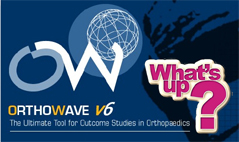It has been a long time we have not posted anything on this Community Blog. We are terribly sorry for that and sincerely apologize. In fact we have not stopped to work on new improvements and extensions to the OW program, and will soon be able to present some new exciting features through our Community web pages.
OrthoWave is more and more used for scientific purposes in hospitals, study groups, and Orthopaedic societies, and thus we have spent much time to accompany our new users and help them to get started appropriately. In addition, two side imaging programs as PIAM (PictIn Automatic Measurements) have been designed from Pictin in order to automatically get upon a few clicks on any hip or knee image either pelvic or knee critical measurements to be then sent back to OW and used for scientific works; two video tutorials will soon describe in details these exciting programs. Let’s say that the shoulder and spine modules have been already designed and will be released as soon as an agreement can be found with both surgeons and companies for supporting these developments. Moreover, OrthoWave as an ideal outcome study tool and/or registry, has also been presented as “EstheWave” in the area of Esthetic Surgery, and namely for the follow-up of breast implants; other developments in other domains of medicine have been anticipated, be they cardio-vascular, dermatology, digestive apparatus, or again ophthalmology. Some ventures are also on trails to enhance the ability for OrthoWave to provide top class studies for regulatory management at a very low price, thanks to our Monitored Data Bases (MDBs), which can be seen as ideal nowadays, when so many concerns regard both financial crisis against higher needs for evaluation in Medicine.
Anyway, as OrthoWave enters its 17th-year of existence since it was firstly designed in 1996, the number of our users is constantly growing. The balance sheet is highly positive with currently 126 OrthoWave data bases (RDBs, SDBs and MDBs) in use, mainly in Europe (France, Belgium, UK, Italy, Greece, Turkey), but also in Australia/ New Zealand, and in Latin America (Chile). The number of registered patients available for studies reaches 185,244 forms to date, including 176,323 hips and 37,977 knees. On the whole, 1207 surgeons are duly registered within the various databases, and their data can be analyzed by 891 users. Our idea while designing this OrthoWave software suite aimed to provide a “standard” tool for any kind of study, be it scientific or upon regulatory matters; in fact, more and more Hospital staffs are using nowadays OrthoWave as a routine procedure, and younger trainees and residents are used addressing OrthoWave even after they leave Hospitals to get started in private institutions. This is extremely encouraging and may justify all our efforts to stay at the cutting edge of technology while keeping at best the “user friendly” specific touch that characterizes OrthoWave.
We often are asked about the relationship between registries and outcomes studies softwares… More and more nowadays, National registries are regarded as “Evidence Based Medicine”… During the past EFORT meeting in Berlin, or during the EHS in Milano recently, numerous presentations and debates claimed for registries as the unique cursor for what is good and what is poor in terms of arthroplasty outcomes. In fact, while simply taking in consideration a binary variable as “revised or not?”, registries may be seen as a useful satellite image of various orthopaedic implants and are able in good manners to serve as warning signs for any disappointing results. However they cannot replace real “Evidence Based Medicine” which must take into consideration clinical and radiological outcomes, as well as adverse effects and morbidity, even not leading to revision. Outcome studies softwares, as OrthoWave, are here to stay. Beyond simple “epidemiology”, they can represent at best promising “observational registries”. More to see!…
